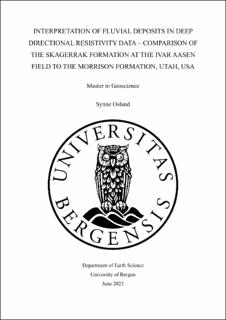| dc.description.abstract | Fluvial deposits are important reservoirs in the subsurface and may host significant amounts of hydrocarbons and will offer significant volume for subsurface CO2-storage in the future. Such reservoirs are commonly complex and may have significant heterogeneities, both on the inter- and intra-sandbody scale, that can lead to complicated fluid movement and poor reservoir drainage. Deep Directional Resistivity (DDR) data are often used for well steering while drilling in such deposits, but it is possible that geological information derived from detailed analysis of DDR data may also be used to significantly improve reservoir models in such reservoirs. In this thesis I will investigate if DDR data can be used to better develop sedimentological models for subsurface fluvial reservoirs, to choose analogs for subsurface deposits, and to determine subsurface intra-sandbody heterogeneity when common limitations of the DDR tool are considered. The Skagerrak 2 interval (SK2) of the Upper Triassic Skagerrak Formation at the Ivar Aasen Field in the northern North Sea constitutes an important dryland fluvial reservoir and importantly, has large amounts of DDR data. Combined with a dataset of six cored vertical wells, exceptional constraints on subsurface sandbody geometries are offered. Understanding the heterogeneities of a fluvial reservoir is essential, especially in the Skagerrak 2 interval, where the reservoirs connectivity and intra-channel variability is not well understood. Here, I present a comparative study of subsurface data from the SK2, and the similar outcrop analogue of the Morrison Formation in Utah, USA. The Morrison Formation is extensively studied and is well exposed in the field. These formations show similar depositional elements, but the sand fraction and channel dimensions are larger in the SK2, than within the studied outcrops of the Morrison Formation. The architecture of the SK2 changes from west to east across the Ivar Aasen Field, where the western part is associated with amalgamated channel belts and the largest channel dimensions, and the eastern part is dominated by smaller single- story channel belts. In the Morrison Formation, a similar trend is observed stratigraphically upward within the formation. The Morrison Formation is a good field analogue to the Skagerrak 2 interval where further comparison shows that small-scale resistivity variations in DDR data can relate to intra-channel architectural elements, such as lateral accretion surfaces and point bar deposits. The result from this study indicates that DDR data can be applied to improve the understanding of the internal variations, sand fraction, and geometries of sandbodies. This information can contribute to determine barriers to fluid flow, if care is taken to adjust for these problems, and this is essential knowledge needed to build more realistic geological reservoir models from DDR data of alluvial systems. | |
